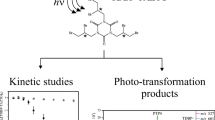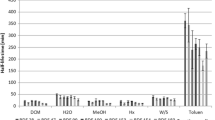Abstract
The European directive RoHS (Restriction of the use of certain Hazardous Substances) limits the use of specific toxic substances for example a number of flame retardants. In the light of this context, this work handles with the implementation of a methodology of deactivation by radiative exposure of Tetrabromobisphenol A bis-(2,3-dibromopropylether) (TBBPA-DBPE), concerned by the RoHS directive. It has been shown that the photodegradation by UV-visible irradiation of TBBPA-DBPE in Tetrahydrofuran as organic environment generates less brominated thus less toxic congeners. Physico-chemical analyses were realized by means of a spectroscopic technique that allows to characterize products before and after irradiation under UV-visible light.
Access provided by CONRICYT-eBooks. Download conference paper PDF
Similar content being viewed by others
Keywords
1 Introduction
A number of substances contained in the Waste of Electrical and Electronic Equipment (WEEE), in particular brominated flame retardants, were identified as molecules with considerable risks for the environment, and forbidden in use. Several brominated flame retardants have proved to be highly bioaccumulative and bioavailable, and can be detected in animal and human tissues, explaining the toxicity of these products. These additives would always be present in current and future deposits, collected from the waste of former or imported products. The concentration of brominated flame retardants in various materials can reach 5–30 % by weight. As a consequence, the method of waste recycling of electric and electronic equipments, which contain these pollutants, remains a real challenge. Indeed, in date, only the incineration is practiced in an industrial way with fatal consequences for the environment.
Certain flame retardants, added to diverse materials, are very effective to reduce the flammability of the finished product and specially the halogenic flame retardants because they contain bromine. The bromine intervenes in chemical reactions which slow down the combustion necessary for the inflammation. Among these flame retardants, one of the most used is the Tetrabromobisphenol A bis-(2,3-dibromopropylether) (TBBPA-DBPE) [1–3]. This product can be found incorporated into various materials, in which it is either chemically bound, or simply added, to confer fireproofing properties to these compounds [4, 5].
These flame retardants became common contaminants of the environment that we could find in human and animal bodies and may cause grave and irreversible effects on the body, like spermatogenesis and mental deficiency [6]. However, it seems that not only the targeted molecules as troublemakers could have an impact on the environment, but also their products of degradation stemming from processes of treatment aiming at their elimination. The process of elimination can be realized by the combination of several steps of treatments such as chemical and biological oxidation [7], and adsorption.
From a chemical viewpoint, the degradation of these pollutants until the final stage (completely debrominated molecules as well as low brominated species) can be obtained by a radical pathway [8–11]. The ultraviolet (UV)-visible irradiation technique seems to be a powerful method to generate with significant efficiency highly reactive radicals in a liquid environment which can react with organic compounds. In particular a Xenon lamp was of use to us as source of irradiation of the UV-visible light.
The photodegradation by UV-visible irradiation in organic solutions may generate less brominated congeners. Indeed, TBBPA-DBPE is sensitive to solar and artificial UV light because of the relatively weak dissociation energy (284 kJ/mol) of the carbon-bromine bond (C-Br).
The objective of this work concerns the implementation of a methodology of deactivation by irradiation of a pure brominated flame retardant (TBBPA-DBPE). The degradation by irradiation in the UV-visible range of TBBPA-DBPE will be followed by analytical methods, allowing the characterization of the products of degradation. In particular, the UV-visible spectroscopic method will be applied.
2 Experimental Part
Tetrabromobisphenol A bis-(2,3-dibromopropylether) (TBBPA-DBPE) (purity 98 %), was obtained from Albemarle corporation. Tetrahydrofuran (THF) was purchased from Merck in HPLC quality. The TBBPA-DBPE molecule as brominated flame retardant is constituted of two phenolic cycles interconnected by an isopropyl group, each one substituted by two bromine atoms situated in ortho-position of the dibromopropylether groups [12]. The corresponding chemical structure of TBBPA-DBPE is shown in Fig. 1.
The irradiation process was carried out using standard 10 mm thick Hellma quartz cells, and the light source was fixed through the central axis of the cell. The distance between UV source and quartz cell was kept at 3 cm. A 150 W Xenon light source from Hamamatsu (model LC8) was used for the irradiation experiments.
During photodegradation experiments, aliquots of solutions containing TBBPA-DBPE were placed in the Hellma cells and submitted to UV irradiation. The initial concentration of TBBPA-DBPE was varied between 0.13 and 0.30 mg/mL in THF. At appropriate sampling times, the photodegradation was finished by removing the vials from the light exposure and immediately initiating analysis.
Absorption spectra were recorded using a Varian Cary 100 UV-visible double-beam spectrophotometer, equipped with a Peltier accessory for precise temperature control (±0.1 °C). All UV absorption spectra were recorded with THF for the determination of quantum yields and computed from the calibration curves in the range 200–400 nm, using the above mentioned Hellma cells at the wavelengths of maximum absorption of TBBPA-DBPE and its photoproducts.
3 Results and Discussion
The radiative effect of the pollutant/solvent system was followed according to the time of exposure to artificial radiation by means of a UV-visible source. This allowed to optimize a number of corresponding parameters (dose of irradiation, distance UV-sample source, temperature, intensity and power of the UV-visible lamp), to increase the efficiency of the photodegradation. The UV-visible spectroscopy was applied to characterize products before and after irradiation under UV-visible light.
The study was realized on dissolved solutions in various organic solvents such as Tetrahydrofuran (THF). The UV-visible light exposure of these solutions as function of time varying from 1 to 90 min allowed to remove the characteristic band of the product at 211 nm [13] and to obtain by-products at 245 and 290 nm, less dangerous than the initial molecule (Fig. 2) [14–18]. It can be concluded that the degradation of TBBPA-DBPE reveals to be very important in THF. An exposure time of 90 min under UV-visible light allowed to degrade 98 % of TBBPA-DBPE for a concentration of 0.05 mg/mL.
Since the pollutant concentration could be an important parameter controlling the degradation process, the effect of the initial concentration of TBBPA-DBPE on the photodegradation rate was investigated over the concentration range from 0.05 to 0.3 mg/mL. Absorption versus irradiation time curves for the 212 nm-band decrease rapidly and exponentially until total disappearance of TBBPA-DBPE after 90 min. The disappearance of TBBPA-DBPE during the first 15 min of debromination can be described by first-order reaction kinetics with regards to the initial concentrations. Figure 3 represents plots of −Ln C(t)/C0 versus exposure time showing linear dependencies, where C0 represents the concentration of TBBPA-DBPE at time zero and C(t) stands for its concentration at time t.
4 Conclusion
The degradation of TBBPA-DBPE in an organic solvent (THF) has been conducted by exposure to radiation in the UV-visible wavelength range, in order to obtain less harmful molecules for the environment. The UV-visible spectroscopy technique was applied to monitor the photolysis as function of irradiation time. The use of a Xenon light source allowed to reveal sequential degradation up to a total deactivation of the TBBPA-DBPE molecule. Especially remarkable was the rapid degradation efficiency shown by the irradiation device, which yields a successful degradation of TBBPA-DBPE, forming lower brominated products. The kinetics of formation and disappearance of intermediate species were determined to follow first order kinetics.
References
Covaci, A., Harrad, S., Abdallah, M.A.E., Ali, N., Law, R.J., Herzke, D., de Wit, C.A.: Novel brominated flame retardants: a review of their analysis, environmental fate and behaviour. Environ. Int. 37, 532–556 (2011). doi:10.1016/j.envint.2010.11.007
Law, R.J.: Tetrabromobisphenol A: Investigating the worst-case scenario. Mar. Pollut. Bull. 58, 459–460 (2009). doi:10.1016/j.marpolbul.2009.02.023
Covaci, A., Voorspoels, S., Abdallah, M.A.E., Geens, T., Harrad, S., Law, R.J.: Analytical and environmental aspects of the flame retardant tetrabromobisphenol-A and its derivatives. J. Chromatogr. A 1216, 346–363 (2009). doi:10.1016/j.chroma.2008.08.035
Haneke, K.E.: Tetrabromobisphenol A bis(2,3-dibromopropylether) review of the toxicological literature. Integrated Laboratory Systems, North Carolina (2002)
European Brominated Flame Retardant Industry Panel (EBFRIP), Statement June 4 (2007)
Lyubimov, A.V., Babin, V.V., Kartashov, A.I.: Developmental neurotoxicity and immunotoxicity of 2,4,6-tribromophenol in Wistar rats. Neurotoxicology 19, 303–312 (1998)
Ronen, Z., Abeliovich, A.: Anaerobic–aerobic process for microbial degradation of tetrabromobisphenol A. Appl. Environ. Microbiol. 66, 2372–2377 (2000). doi:10.1128/AEM.66.6.2372-2377.2000
Eriksson, J., Rahm, S., Green, N., Bergman, Å., Jakobsson, E.: Photochemical transformations of tetrabromobisphenol A and related phenols in water. Chemosphere 54, 117–126 (2004). doi:10.1016/S0045-6535(03)00704-5
Summary risk assessment report prepared by the United Kingdom on behalf of the European Union in http://www.bsef.com/uploads/library/
Lin, K., Liu, W., Gan, J.: Reaction of tetrabromobisphenol A (TBBPA) with manganese dioxide: kinetics, products, and pathways. Environ. Sci. Technol. 43, 4480–4486 (2009). doi:10.1021/es803622t
Guo, Y., Chen, L., Ma, F., Zhang, S., Yang, Y., Yuan, X., Guo, Y.: Efficient degradation of tetrabromobisphenol A by heterostructured Ag/Bi5Nb3O15 material under the simulated sunlight irradiation. J. Hazard. Mater. 189, 614–618 (2011). doi:10.1016/j.jhazmat.2011.02.054
Hamers, T., Kamstra, J.H., Sonneveld, E., Murk, A.J., Zegers, B.N., Boon, J.P., Brouwer, A.: In vitroscreening of the endocrine disrupting potency of brominated flame retardants and their metabolites. Organohalogen Compd. 66, 3016–3020 (2004)
Zhu, L., Hites, R.A.: Brominated flame retardants in tree bark from North America. Environ. Sci. Technol. 40, 3711–3716 (2006). doi:10.1021/es060225v
Faust, B.: Modern chemical techniques. The Royal Society of Chemistry, London (1997)
Stuart, H., Ibarra, C., Abdallah, MA-E., Boon, R., Neels, H., Covaci, A.: Concentrations of brominated flame retardants in dust from United Kingdom cars, homes, and offices: causes of variability and implications for human exposure. Environ. Int. 34, 1170–1175 (2008). doi:10.1016/j.envint.2008.05.001
Guo, Y., Zhou, J., Lou, X., Liu, R., Xiao, D., Fang, C., Wang, Z., Liu, J.: Enhanced degradation of tetrabromobisphenol A in water by a UV/base/persulfate system: kinetics and intermediates. Chem. Eng. J. 254, 538–544 (2014). doi:10.1016/j.cej.2014.05.143
An, J., Zhu, L., Wang, N., Song, Z., Yang, Z., Du, D., Tang, H.: Photo-fenton like degradation of tetrabromobisphenol A with grapheme-BiFeO3 composite as a catalyst. Chem. Eng. J. 219, 225–237 (2013). doi:10.1016/j.cej.2013.01.013
Zhong, Y., Liang, X., Zhong, Y., Zhu, J., Zhu, S., Yuan, P., He, H., Zhang, J.: Heterogeneous UV/Fenton degradation of TBBPA catalyzed by titanomagnetite: catalyst characterization, performance and degradation products. Water Res. 46, 4633–4644 (2012). doi:10.1016/j.watres.2012.06.025
Author information
Authors and Affiliations
Corresponding author
Editor information
Editors and Affiliations
Rights and permissions
Copyright information
© 2017 Springer International Publishing AG
About this paper
Cite this paper
Bentaleb, K., Bouberka, Z., Nadim, A., Maschke, U., Agguine, Y., Eddarir, S. (2017). Deactivation of Polybrominated Flame Retardants by Ultraviolet Radiation. In: Oral, A., Bahsi Oral, Z. (eds) 3rd International Congress on Energy Efficiency and Energy Related Materials (ENEFM2015). Springer Proceedings in Energy. Springer, Cham. https://doi.org/10.1007/978-3-319-45677-5_14
Download citation
DOI: https://doi.org/10.1007/978-3-319-45677-5_14
Published:
Publisher Name: Springer, Cham
Print ISBN: 978-3-319-45676-8
Online ISBN: 978-3-319-45677-5
eBook Packages: EnergyEnergy (R0)







